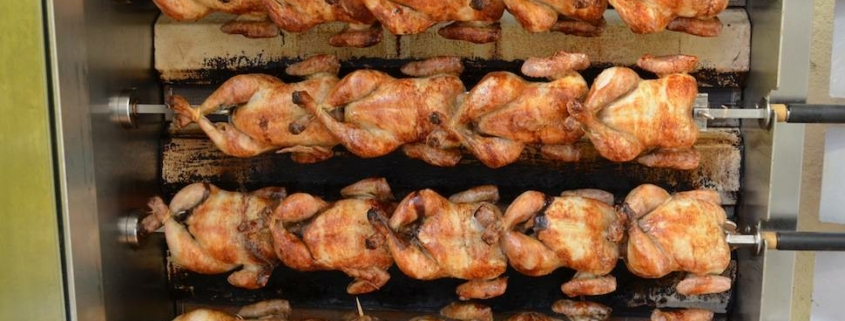ANALYSIS OF ROASTING CHICKEN IN FACE OF A SUMMER MARKED BY COVID-19
Proximity and delivery establishments (home delivery) as ways to reach Spanish families with a healthy product with an eminent social character.
From the Interprofessional Association of Poultry Farming of Chicken Meat / Propollo, which brings together more than 95% of the poultry sector in Spain, it is analyzed how the rotisserie chicken, a typical Spanish product, closely linked to the seasonality of summer and the influx of international tourists, has adapted to the “new normal”.
Spokesperson: Jordi Montfort, Secretary General of Propollo.
Context of the poultry and broiler chicken sector
- Before COVID-19, around 46 million chickens were produced each month in Spain, where seasonality dictated the type of product that was demanded in the market.
- During the summer months, the HORECA channel, to which 25% of production is usually derived during the rest of the year, redistributes products aimed at communities and restaurants (composed mainly of carcass pieces, fillets and wings), to the well-known as rotisserie chicken, typical of bars, restaurants with terraces, stands at patron saint festivities, either establishments with takeaway food, as well as beach. Although demand also increases in distribution channel In coast.
- The demand derived from tourism in coastal areas, where it was also noticeable The arrival of foreign tourists caused this figure to rise.. In total, 52.8 million tourists arrived in Spain each summer, with an average consumption of 500 grams of chicken, which makes a total of 26.4 million Kgs.
- About 35 million chickens (the aforementioned 25% from production) were allocated during the 3 summer months to the HORECA channel (more than 49 million Kg).
How has COVID-19 affected
- After the first confinement measures were decreed in March and the total closure of the HORECA channel, as well as the absolute paralysis of international and national tourism, producers saw how that 25% of production oriented to this channel completely disappeared, although an important part was already planned for the months of April, May and June.
- Producers (farms and integrators) have barely had the opportunity to adapt their production to real demand, since they need at least 3 months to do so due to the chicken breeding cycles.
- Therefore, a part of the product was already on the farms, and part of this production has had to be kept cold (frozen), although there has been no support from the Administration for this concept, unlike other products such as sheep. , goat, bovine or pig.
Rotisserie Chicken: product typology & sector distribution
- The rotisserie chicken corresponds to a specimen of approximately 1.4 kg. To reach the market, this chicken spends an average of 36 days on the farms.
- The sales price in establishments is also a very important factor for its acquisition by consumers. It is usually between €8 and €12, depending on the geographical area and type of preparation.
- Some of the specialized distributors in the HORECA channel itself have had to adapt your production to other types of products, but this has already been done for the months of July-August-September.
- The news of deconfinement and possible recovery of domestic tourism has barely allowed producers any room for maneuver to adapt the raising of rotisserie chicken.
- The most optimistic figures, subject to recent outbreaks and new confinement measures, speak of a lawsuit regarding 7 million copies (a 20% of the usual 35 million).
- But it is a figure that fluctuates and is also subject to new news regarding the cancellation of international tourism, especially British tourism on the coasts.
- And also for chicken imports from surplus countries such as Italy or Poland, in addition to the usual ones from Brazil. It is estimated that 15% of chicken consumption in the HORECA channel comes from imports.
The Spanish restaurant and hospitality industry adapts to new habits
- Some of our associates, especially integrators, already chose to participate in previous years in restaurant projects with direct sales, which also made it easier to have establishments selling prepared food throughout the country.
- This activity is added to that of distribution of rotisserie chicken for restaurant chains, small businesses, bars, beach establishments, hypermarkets selling prepared food dishes, etc.
- All of these establishments have seen how an important factor in the new normal has been the Delivery options (home delivery), as well as the proposal of food to pick up in store upon request, including the request sometimes by telephone and other times online.
- Both restaurant chains and individual establishments opt for this type of service as a way to facilitate access to a prepared meal linked to family or leisure consumption at home.
- We have detected that this option is also linked not only to coastal sites, but also in large cities like Madrid, Barcelona or Seville. The delivery option allows consumers to have a healthy diet at home, as well as Promote the business of small neighborhood businesses.
- For some establishments in inland cities, this type of sales strategies and proximity to local customers has meant that the decline in sales may have been less than expected, below the national average.
- An interesting option is also being the prepared food spaces of hypermarkets, such as El Corte Inglés, Mercadona or Eroski. Although its adaptation to the new normal remains to be seen.

